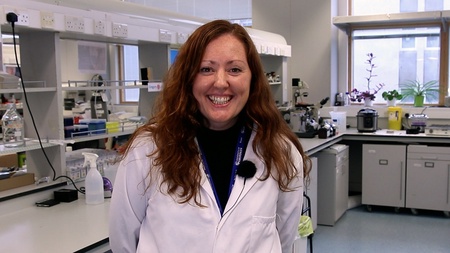Scientists from the University of Aberdeen in collaboration with the University of Edinburgh and international partners, have identified a new way to detect signs of motor neurone disease (MND) in brain tissue that can pick up indicators of MND earlier and with more sensitivity than currently used tests.
Using a molecule known as an “aptamer”, which has already revolutionised cancer diagnostics recently, the team have successfully applied it to MND detection in brain tissue samples.
The TDP-43 aptamer identified damaged cell proteins in brain tissue samples that can indicate MND before the cells malfunction - when symptoms would start to appear and the is stage at which current tools can detect signs of the disease.
Dr Holly Spence, a co-author of the study from the University of Aberdeen said: “Our findings have implications for early diagnostics and intervention prior to symptom onset in MND.
“With better ability to detect disease we might be able to diagnose people with MND earlier, when therapeutic drugs might be much more effective.”
Funded by Target ALS, the findings are published in Acta Neuropathologica.
The research, led by Dr Jenna Gregory from the University of Aberdeen, predicts the newly developed aptamer could trigger a step-change in MND research, supplementing or replacing some traditional antibody approaches for detection.
Dr Gregory explains: “This tool ‘targets’ the disease protein and allows us to see where toxic clumps are building up in the body. It can do this for much lower amounts of disease proteins, and with greater accuracy than ever before.
“This could be a game-changer for MND research, diagnostics and treatment.”
Dr Fergal Waldron from the University of Aberdeen, who co-authored the study, adds: “We are using the tool to uncover previously hidden insights into how MND makes people sick. Fundamentally, using this tool we have found out that toxic protein clumps are building up well before people show symptoms.
“This deeper understanding of the changes that happen in brain tissue at such an early stage has enormous potential for future research into the disease.”
Motor neurone disease, also known as ALS, affects around 5000 people in the UK and is caused by the accumulation of certain proteins in the brain that clump together, causing the cells to gradually stop working and, as the disease progresses, it impairs movement, thinking and breathing, which worsens over time.
Early detection of these accumulating proteins in people with MND remains a major challenge to successful treatments. As new medicines become available, it is vital to be able to measure the effectiveness of medicines in clinical trials. This tool, the team say, can help address this issue.
Using small RNA molecules to tag the abnormal protein clumps rather than the usual, larger, antibody methods, the accumulating proteins can be detected at much lower levels and with higher accuracy. The improved accuracy of this new detection tool revealed that these proteins can start to make small clumps in the brains of people with MND before those brain regions show symptoms.
The team is being supported by Edinburgh Innovations, the University of Edinburgh’s commercialisation service, to license the patented TDP-43 aptamer.
Dr Mathew Horrocks from the University of Edinburgh added: “This is the first time that our TDP-43 aptamer has been used in human tissue and we’re excited by its ability to detect a pathological form of the protein that has so far been difficult to characterise.”
In support of the research, Dr Brian Dickie, Director of Research at the Motor Neurone Disease Association, said: “It often takes a year from the first onset of symptoms to receiving a diagnosis of MND. This innovative research into the early cellular changes occurring in MND offers exciting potential for the development of new tests to help reduce diagnostic delay. As treatment does not begin until the disease is diagnosed, earlier intervention will hopefully also mean that treatments are more effective."
Dr Jane Haley, Director of Research at MND Scotland, added: “Early detection of MND in people is essential as we move towards a time when treatments that modify progression of the disease could become available.
“Step changes in technical approaches – such as moving away from antibodies towards smaller synthetic RNA molecules, as with this aptamer – can accelerate progress by unlocking new lines of research, leading to new insights.
“Whilst this current development is not an early diagnostic test, it could help researchers reach that goal.”
Jessica Lee, Director of Research at My Name’5 Doddie Foundation, added: “Motor neurone disease is a devastating condition for which there are currently no effective treatments and long delays in diagnosis.
“Due to advancements in research, many potential treatments are currently being explored in the lab and in clinical trials. However, we now need robust biomarkers of disease to support the evaluation of these treatments and to speed up diagnosis, so that treatments can be started earlier in disease progression. This exciting new technology holds promise to do just that.”


